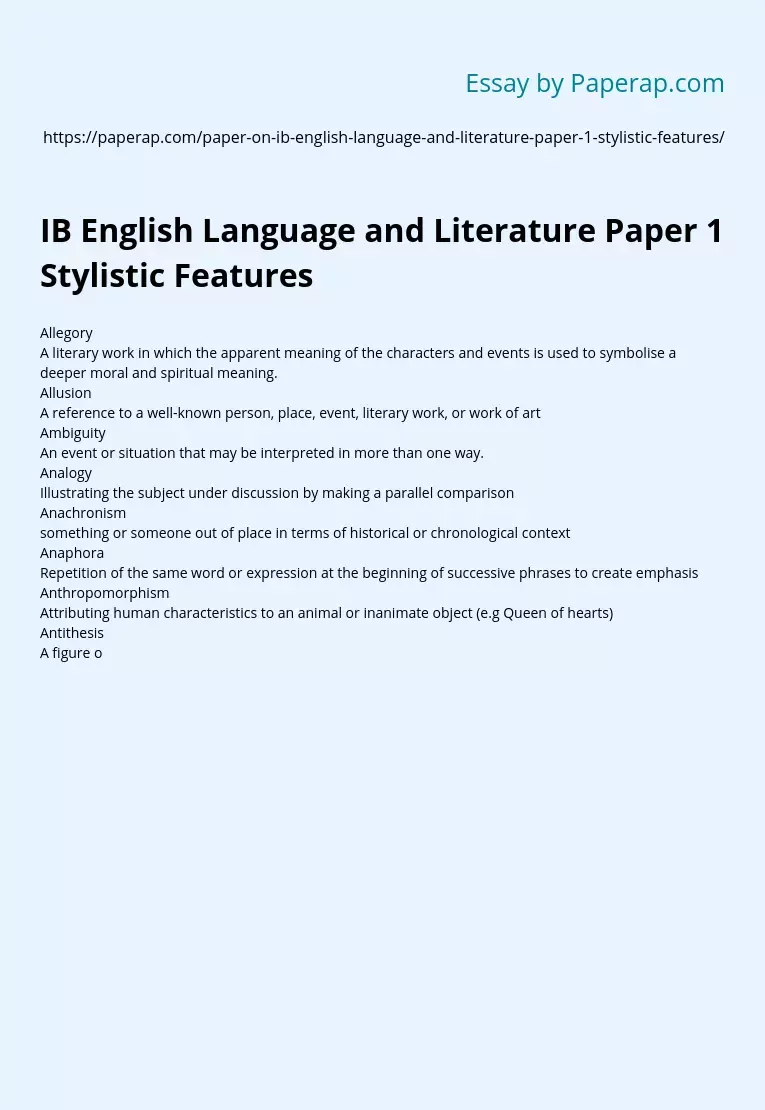IB English Language and Literature Paper 1 Stylistic Features
Essay,
Pages 2 (427 words)
Views
2463
Allegory
A literary work in which the apparent meaning of the characters and events is used to symbolise a deeper moral and spiritual meaning.
Allusion
A reference to a well-known person, place, event, literary work, or work of art
Ambiguity
An event or situation that may be interpreted in more than one way.
Analogy
Illustrating the subject under discussion by making a parallel comparison
Anachronism
something or someone out of place in terms of historical or chronological context
Anaphora
Repetition of the same word or expression at the beginning of successive phrases to create emphasis
Anthropomorphism
Attributing human characteristics to an animal or inanimate object (e.
g Queen of hearts)
Antithesis
A figure of speech in which a thought is balanced with a contrasting thought.
Anecdote
A short account of an particular situation or incident
Apostrophe
Where a speaker addresses a person or object that is not alive
Archaism
Intentional use of a word or expression no longer used to evoke a sense of a bygone era
Bias
Promoting on specific point of view in a text and deliberately excluding others
Connotation
Suggestion of a word meaning beyond what it explicitly denotes
Cliche
A stereotypical expression which is overused
Diction
Choice of words
Ellipsis
The omission of words necessary to complete a sentence (…) or (-) used for dramatic effect, tension, confusion, etc.
Enumeration
Listing items in order.
Euphemism
a word or phrase that is used in a place of a more direct term that might be offensive.
Exposition
Where an author interrupts a story in order to explain something.
Figurative Language
Any use of language where the intended meaning differs from the actual literal meaning of the words themselves (inc. metaphor, simile, personification, irony, etc)
Hyperbole
An extremem exaggeration
Imagery
Words that create a picture in the reader’s mind
Irony
A literary device that uses contradictory statements or situations to reveal a reality different from what appears to be true.
Oxymoron
Two apparently contradictory terms
Paradox
A statement that appears self-contradictory, but that reveals a kind of truth
Parallelism
Use of similar or identical language, structures, events or ideas in different parts of a text.
Satire
The ridicule of something the writer dislikes
Sensationalize
Describing something in an exaggerated way to shock and engage the reader.
Syntax
Arrangement of words and phrases to create sentences.
Understatement
A statement that says less than what is meant
Euphony
Denotes pleasant, harmonious sound
Cacophony
Denotes harsh, jarring noise
Hypophora
Asking a question and then answering it.
Tricolon
Sentence of three parts of equal importance and length, usually three independent clauses.
IB English Language and Literature Paper 1 Stylistic Features. (2018, Feb 15). Retrieved from https://paperap.com/paper-on-ib-english-language-and-literature-paper-1-stylistic-features/

